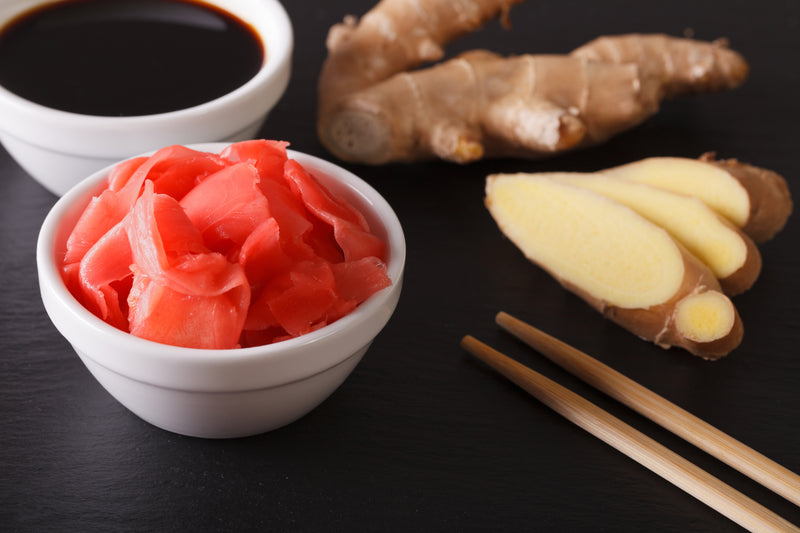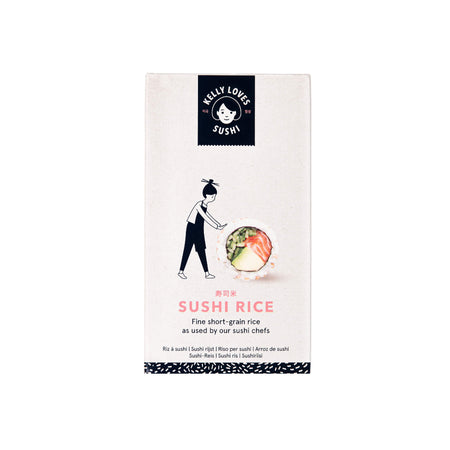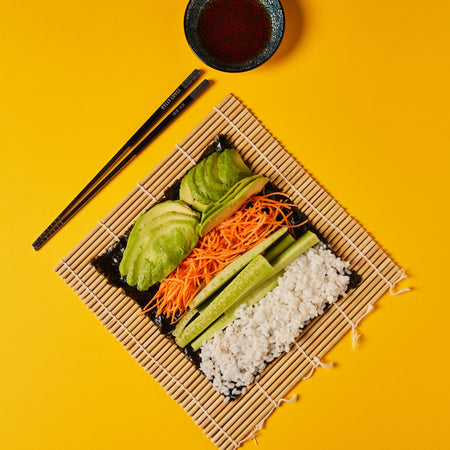7 Popular Sushi Condiments & Accompaniments
The flavours of sushi dishes can be incredible. Beautifully fresh seafood or skillfully sliced meat, on a tiny bed of perfectly prepared sushi rice…it can be a real treat for your taste buds.
So the last thing you want to do is ruin those delicately balanced flavours with too much soy sauce or the wrong sushi condiments.

Let’s take a look at some of the most popular accompaniments – and how to use them so you get sushi that leaves you wanting more.
Sushi accompaniments and condiments
What do Japanese people eat sushi with? Well that all depends on the type of sushi dish on the table and, of course, personal preference.
Condiments are particularly popular when there are minimal sushi ingredients involved. Take dishes like nigiri sushi, for example. When it’s just a ball of rice and a thin slice of seafood or meat, there’s more room for complementary flavours. Here are some of those flavours.
Miso paste
Miso paste is made from fermented soybeans, salt and a type of fungus called koji. Sometimes, rice, barley or seaweed is also used.
The mixture is fermented for a significant amount of time, from several months to several years. At the end of all this, you get thick, savoury and salty paste that works well as both a flavouring and a seasoning.
Different types of miso and fermentation periods result in different tastes, but generally, it’s particularly well-suited to soups and dressings. Some people also use it as a spread or dip.
But not only does it taste great. There are all kinds of vitamins, protein and minerals in there, as well as the probiotics that can aid healthy digestion.
Pickled ginger
Pickled ginger – or “gari” in Japanese – is a very common sight in Japan, appearing alongside dishes like sashimi and tempura. It’s made by slicing ginger thinly and marinating it in vinegar, sugar and salt. This gives it a sweet but tangy, and slightly spicy flavour.
Since it’s often used as a palate cleanser with sushi, pickled ginger is also known as sushi ginger. In Japanese cuisine, there’s a great emphasis on using high-quality, freshly prepared ingredients. So that you can really taste that quality, ginger is often offered alongside sushi. Have a little between dishes or pieces of sushi to maximise the impact of the flavours on your plate.
And don’t worry if you find yourself going back for more ginger: it fights inflammation and helps your digestion.
Soy sauce
Soybeans, wheat, water and salt – that’s all that goes into soy sauce.
When you’re indulging in some tasty Japanese food, soy sauce is never a bad choice. It’s incredibly versatile and comes in dark, light, sweet and other varieties.
One thing to note: if you’re eating it with sushi, dip the topping into the sushi soy sauce, not the rice. The rice in sushi is made with sushi vinegar, which means it’s already got plenty of flavour. Plus, the rice could soak up too much sauce and overpower the rest of the dish.
Teriyaki sauce
For a sweeter taste, chefs turn to teriyaki sauce. It’s usually used to marinate broiled or grilled foods, which often means seafood like tuna, salmon or trout in Japanese kitchens. “Teri” means shine and “yaki” means grill or boil.
The sauce is made by mixing our old friend soy sauce with sugar (or honey) and sake (or mirin rice wine). Ginger and garlic are sometimes added as well.
Sesame oil
From stir-fries to marinades, sesame oil is used in all kinds of Japanese cooking. For salads, it’s combined with soy sauce, rice vinegar and sugar to create a sweet/savoury dressing.
But it’s also a great condiment in its own right, adding a wonderful nutty flavour and aroma. It makes a perfect seasoning for udon and soba noodles, in particular. And Japanese diners use it as a dipping sauce for everything from raw vegetables to gyoza and tempura. It’s also commonly found as one of the sauces served with sushi and shabu-shabu (a hotpot dish of thinly sliced meat and vegetables in a tasty broth).
Rice vinegar
It sometimes seems like rice vinegar is everywhere in Japanese cooking. That’s why we always include it in our sushi making kits. It pickles vegetables. It goes into meat marinades. And it’s a crucial part of sushi rice.
But you might also encounter rice vinegar in dipping sauces. It’s used as a base for various sauces, often alongside soy sauce. It’ll add a bit of acidity and bring out the flavours in dishes like sushi, gyoza, tempura and soba noodles.
Horseradish for sushi
When it comes to condiments for sushi and sashimi, wasabi is always a favourite. Its hot, sharp taste is a particularly good match for fresh seafood. Many people mix a small amount with soy sauce to create a new dipping sauce.
But outside of Japan, ‘wasabi’ is usually a mixture of horseradish, mustard and green food colouring. Why? Well fresh wasabi is difficult to find and expensive in most places other than Japan. It comes from the root of the wasabi plant, which is in the same family as horseradish.
There’s a huge variety of Japanese condiments for sushi and other dishes – and we’ve only just scratched the surface here. But with a little bit of insight into some of the most popular options, you can now pair your favourite Japanese dishes up with delicious dips and accompaniments.









